
Other designs: Sail and oar, rowing boats

You will find on this page sail and oar and rowing boats I have designed. These boats are not presently produced or were custom built, but they may be a basis for a new project, nearly identical or only similar. See my stock plan catalogue for ready to build plans.
| Hull length: | 4 m | Breadth: | 1.6 m | Light weight: | 550 kg |
Sail area: | no sail |
|---|
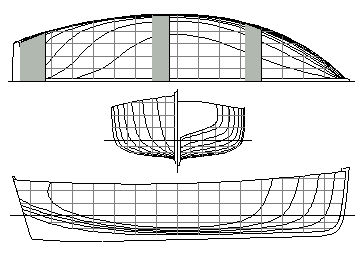 This
boat has been designed in 1998 as a training boat for a seafarer's
school, propelled by a sculling oar. She was traditionally built by
Yvon Clochet. This
boat has been designed in 1998 as a training boat for a seafarer's
school, propelled by a sculling oar. She was traditionally built by
Yvon Clochet.Sculling is a very efficient way of propulsion in sheltered waters. I have practiced it on boats up to 10 m. |
| Hull length: | 4.6 m | Breadth: | 1.45 m | Light weight: | 190 kg |
Sail area: | 10 m² |
|---|
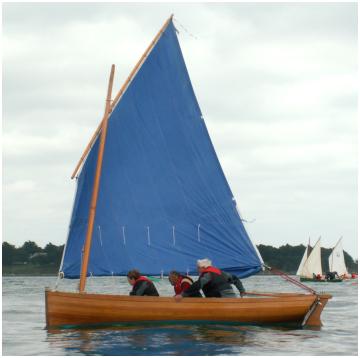 Aven
is may first sail and oar design. From 1982, about 100 units have been
built by Chantier Naval de Loctudy. She is strip planked over steam
bent frames. Aven
is may first sail and oar design. From 1982, about 100 units have been
built by Chantier Naval de Loctudy. She is strip planked over steam
bent frames.Hull forms are inspired by traditional boats of Brittany, with a plumb stem and a raked transom. The "misainier" rig, a standing lug without boom, is both easy to use and efficient, thanks to her highly peaked yard. When tacking, the helmsman has just to change the sheet from side to side. Aven is fitted with a daggerboard to improve windward ability. |
| Hull length: | 4.9 m | Breadth: | 0.90 m | Light weight: | 55 kg |
Sail area: | no sail |
|---|
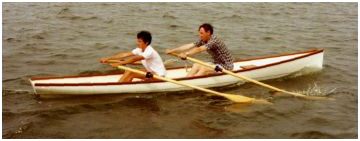
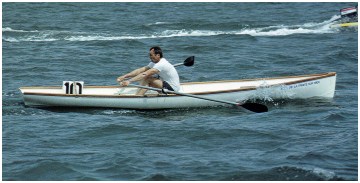 Yole
16 is a pulling boat designed in 1982 for Gérard d'Aboville., a man who
crossed both Atlantic ocean and Pacific ocean on rowing boats and
wanted to promote sea rowing. Yole
16 is a pulling boat designed in 1982 for Gérard d'Aboville., a man who
crossed both Atlantic ocean and Pacific ocean on rowing boats and
wanted to promote sea rowing.It is possible to rig it with one or two fixed seats (top picture) or with one sliding seat (bottom picture with Eric Tabarly). About 300 Yoles 16 were grp built in the eighties. |
| Hull length: | 5 m | Breadth: | 1.45 m | Light weight: | about 120 kg |
Sail area: | several rigs |
|---|
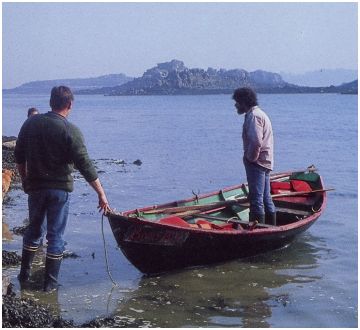 A small swamscott dory type hull designed as a tender for An Durzunel. She was built in plywood, using the stitch and tape method. A small swamscott dory type hull designed as a tender for An Durzunel. She was built in plywood, using the stitch and tape method. |
| Hull length: | 6.8 m | Breadth: | 1.88 m | Light weight: | 400 kg |
Sail area: | 18.5 m² |
|---|
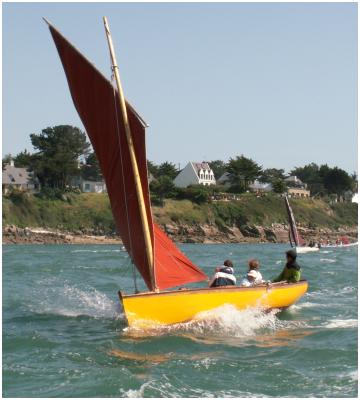 Odet
yole was drawn in 1992 for several villages around the Odet river, near
Quimper in Brittany. The single high lug sail is adapted to sail
in the river. Odet
yole was drawn in 1992 for several villages around the Odet river, near
Quimper in Brittany. The single high lug sail is adapted to sail
in the river.About 10 units have been builts, strip planked over steam bent frames, with a dagger board. |
| Hull length: | 8 m | Breadth: | 2.15 m | Light weight: | 480 kg |
Sail area: | 27 m² | EU Category: | C |
|---|
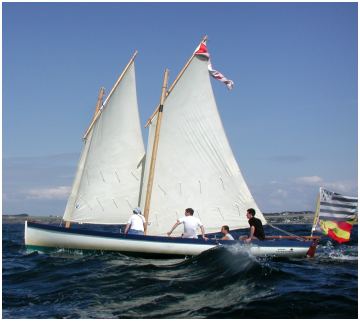   Yole Morbihan was designed in co-operation with Jean-Michel Viant as an alternative to the large and expensive Bantry yole (see below) for several associations around the Morbihan gulf. The hull is grp built with wooden arrangements inside. A pivoting centerboard is located just aft of main mast. Yole Morbihan is essentially dedicated for use by a crew of 7. She has three thwarts and rowing is done with two people per thwart. She is a very good boat for youth organisations. I have made a project of an improve version, including an optional arrangement for an outboard motor. See drawing. If a builder is interested in marketing such a bot, please contact the designer. |
| Hull length: | 9.60 m | Breadth: | 1.70 m | Light weight: | 250 kg |
Sail area: | sans |
|---|
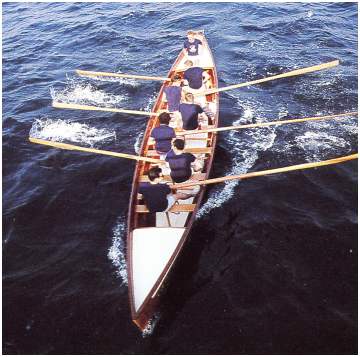 In
1982, Gérard d'Aboville wanted to promote the practice of sea rowing
and ask me to design a boat, similar to scilly island gigs, but cold
moulded. Several units were built and regatas organised along the
French coast. In
1982, Gérard d'Aboville wanted to promote the practice of sea rowing
and ask me to design a boat, similar to scilly island gigs, but cold
moulded. Several units were built and regatas organised along the
French coast. |
| Hull length: | 11.62 m | Breadth: | 2.12 m | Light weight: | 900 kg |
Sail area: | 39 m² | EU Category: | C |
|---|
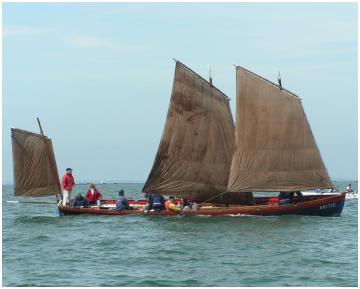 In
1982, the french magazine "Chasse-Marée" and Lance Lee (Rockport
apprenticeshop, USA) launched Atlantic Challenge: an annual meeting
of boats from different countries with the aim to keep alive
traditional seamanship. They chose the Bantry gig, a French officer
boat from the frigate "La Résolue" which was wrecked in Bantry bay
(Ireland) in 1796 but was kept ashore under shelter and finally was
saved in the Dublin maritime museum. In
1982, the french magazine "Chasse-Marée" and Lance Lee (Rockport
apprenticeshop, USA) launched Atlantic Challenge: an annual meeting
of boats from different countries with the aim to keep alive
traditional seamanship. They chose the Bantry gig, a French officer
boat from the frigate "La Résolue" which was wrecked in Bantry bay
(Ireland) in 1796 but was kept ashore under shelter and finally was
saved in the Dublin maritime museum.The first Bantry gig were built in the USA and I was asked to drawn a sail plan according to historical documents, as not any vestige of the original was evident in the museum boat. Websites related to the Atlantic Challenge : http://www.atlanticchallenge.org/ http://www.atlanticchallenge.com/ |